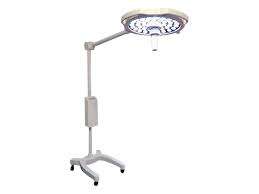

OT (OPERATION THEATER) LIGHT
An OT (Operating Theatre) light is a specialized lighting fixture used in surgical environments to provide optimal illumination for medical procedures. Designed to meet the precise lighting needs of surgical teams, OT lights offer several critical features to ensure effective and safe operations.
The primary function of an OT light is to deliver bright, shadow-free light with adjustable intensity and focus, allowing surgeons and medical staff to see the surgical field clearly. These lights are designed to minimize shadows and provide consistent, high-quality illumination even in complex procedures.
Modern OT lights are equipped with advanced technology, including LED or halogen bulbs, which offer bright and durable lighting with minimal heat output. They often feature adjustable arms and positioning controls, allowing for flexible placement and precise direction of light to the surgical area.
O.T. ( Operation Theater) Light : A surgical light – also referred to as an operating light or surgical light head – is a medical device intended to assist medical personnel during a surgical procedure by illuminating a local area or cavity of the patient. A combination of several surgical lights is often referred to as a “surgical light system
O.T. ( Operation Theater) Light : A surgical light – also referred to as an operating light or surgical light head – is a medical device intended to assist medical personnel during a surgical procedure by illuminating a local area or cavity of the patient. A combination of several surgical lights is often referred to as a “surgical light system
Features
- Brightness and Intensity: Ensure the light provides adequate, adjustable brightness for clear visibility of the surgical field.
- Shadow Control: Choose a light with effective shadow reduction to maintain consistent illumination.
- Color Temperature: Opt for lights with adjustable color temperature to accurately render tissue colors.
- Adjustability and Flexibility: Look for lights with flexible positioning and easy maneuverability to adapt to different surgical needs.
- Ease of Cleaning: Select lights designed with smooth, disinfectable surfaces to maintain sterile conditions.
- Heat Management: Ensure the light has effective heat dissipation to prevent discomfort for both patients and medical staff.
- Energy Efficiency: Opt for energy-efficient lighting solutions, such as LED, to reduce operational costs and extend bulb life.
- Control Options: Look for intuitive control systems that allow for easy adjustments of light intensity, focus, and color temperature.

